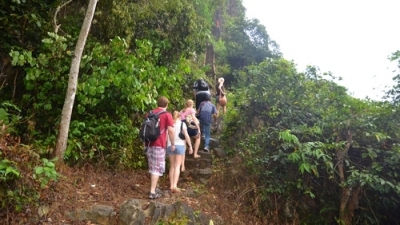Efforts made to preserve biodiversity in Cat Ba National Park
Cat Ba National Park in the northern port city of Hai Phong is a safe haven for thousands of creatures, including many rare animals. Biodiversity in this park has been protected and promoted thanks to the tireless efforts of the local government and community.

Many scientific research studies have been undertaken to preserve and promote the biodiversity of the park and conserve precious genetic resources from species facing extinction, he said.
Phien asserted that the most successful project of the park has been protecting the ‘Vooc Cat Ba’ (scientifically known as Trachypithecus poliocephalus), an endemic animal found exclusively on Cat Ba island.
Neahga Leanard, the project manager, said after nearly 20 years of implementation the project has raised the number of Vooc Cat Ba from 40 to 65.
Leanard stressed that the protection of the animal is an urgent necessity and requires joint efforts from the whole community.
He also noted that in the last seven years, there have been no instances of poaching of the animal.
As part of efforts to safeguard biodiversity in the park, the People’s Committee of Cat Hai district has urged local schools to integrate environmental protection content into students’ curriculum.
The park’s management board has also coordinated with local authorities to raise public awareness of the importance of protecting biodiversity, calling for stronger engagement in preserving the ecosystem in line with developing tourism.
Experts have also guided local households in applying new and effective production models, raising their incomes and reducing their exploitation of natural forests, said Phien.

Foreign tourists visit Cat Ba National Park
Covering 17,000 hectares on Cat Ba Island in the Cat Hai district, the park is one of the world biosphere reserves in Vietnam and hosts endemic biological systems typical of 2,799 coastal islands in Vietnam.
According to Nguyen Van Phien, Vice Director of the park, so far, as many as 1,561 floral species have been discovered in the park, together with 338 vertebrate animals and 1,313 maritime species.Many scientific research studies have been undertaken to preserve and promote the biodiversity of the park and conserve precious genetic resources from species facing extinction, he said.
Phien asserted that the most successful project of the park has been protecting the ‘Vooc Cat Ba’ (scientifically known as Trachypithecus poliocephalus), an endemic animal found exclusively on Cat Ba island.
Neahga Leanard, the project manager, said after nearly 20 years of implementation the project has raised the number of Vooc Cat Ba from 40 to 65.
Leanard stressed that the protection of the animal is an urgent necessity and requires joint efforts from the whole community.
He also noted that in the last seven years, there have been no instances of poaching of the animal.
As part of efforts to safeguard biodiversity in the park, the People’s Committee of Cat Hai district has urged local schools to integrate environmental protection content into students’ curriculum.
The park’s management board has also coordinated with local authorities to raise public awareness of the importance of protecting biodiversity, calling for stronger engagement in preserving the ecosystem in line with developing tourism.
Experts have also guided local households in applying new and effective production models, raising their incomes and reducing their exploitation of natural forests, said Phien.

Leave your comment on this story